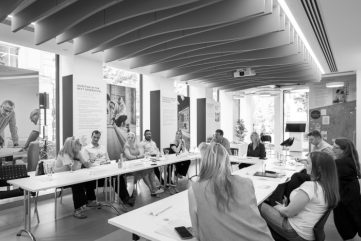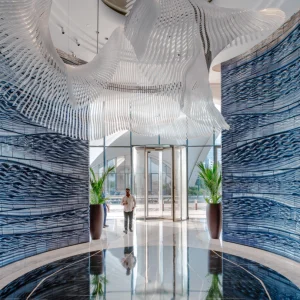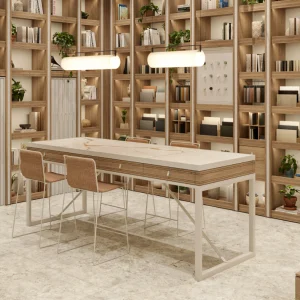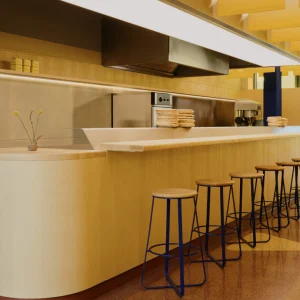
All Images: Gareth Gardner
WITH HYBRID WORKING now a fixture in the office landscape, organisations have had to adjust to a host of changes over the past five years or so. The workplace has taken on a far more flexible and versatile role, both in terms of the numbers of staff present at any one time, and also the ways in which the space is utilised.
Part of the process has been adapting offices to ensure they are destinations that staff actually want to be in, and where they can see the advantages to coming into a work location as opposed to simply working from home five days a week. Invariably, this has meant making the workplace a healthier and more comfortable place, which has skyrocketed the concept of wellness up the corporate priority list.
Several workplace design experts gathered at the Saint-Gobain Build Better Centre in London to discuss the issues around ‘designing for individuals’ and to assess how design can help to improve lives in all kinds of working environments. The conversation started by looking at how a focus on the individual may have begun with principles of wellness.
Helen Berresford, partner and head of id:SR at Sheppard Robson, said: ‘Wellness has been corporatised in recent years, which can be useful in a number of ways. We were lucky enough to work with a large client on a project and they went for WELL Gold certification and really invested in it… because they really wanted to push the boundaries and challenge what well-being was. In fact, they spent a lot of money to design in well-being attributes to the building.
‘It was no mean feat at the time because I think the criteria has even been relaxed a bit since. It was interesting, though, in that a lot of the criteria in wellness is just good design, and the kind of things we’d just want to do normally.
 The conversation started by looking at how a focus on the individual may have begun with principles of wellness. Image Credit: Gareth Gardner
The conversation started by looking at how a focus on the individual may have begun with principles of wellness. Image Credit: Gareth Gardner
‘It was challenging in that we came in part-way, and it was quite an intense project across a large site. The client was very fortuitous in some ways as the building had great natural daylight; light was very much part of the scheme. But we had to change water supplies because you couldn’t get WELL Gold without having filtered water. We needed new systems that didn’t exist necessarily in the UK, to filter the water because normal London water didn’t match the criteria. There were also some complex, technical aspects such as air quality and other things to do with the quality of the working environment.’
Key details went down to an even smaller, human level: ‘A lot of the accreditation has been established on the basis of there being a business – including financial – benefit to be had. If you get healthier people, you are not spending so much money on health insurance. In the States it is a very different kind of model, so there was even a focus on the plate size for free meals and how, by reducing them by 30%, you could bring about certain health benefits.
‘So, amongst all the complexity and money that is being invested in this topic, from a corporate point of view there is still mileage in talking about what we eat, and putting that into the equation of how you design the space and the building. From a designer’s point of view, this all makes so much sense, but to be sitting there in a boardroom talking to really senior players about size of plates and creating space for rest, it was just really healthy in itself.
‘Rest was the hardest thing for their teams to grapple with. The accreditation requires a wellness room for relaxation but the conversation – and angst – about creating places to rest in the working day highlighted a real difference in work ethics.’
Theresa Dowling, editor of FX and chair of the discussion, asked: ‘Did you design spaces that were completely different from where the worker would normally be for the restroom? Is the ‘rest’ room more like a hotel room, for example?’
 Paige Hodsman of Ecophon. Image Credit: Gareth Gardner
Paige Hodsman of Ecophon. Image Credit: Gareth Gardner
‘There was lots of discussion about that because a precedent for a ‘gold restroom’ didn’t exist anywhere,’ Berresford replied. ‘But in the case of this client, they had a space on the 11th floor, which was more of team space, which had really great views, a terrace and games room. Not only did they embrace what was quite an alien concept, but they have preserved it and, five years later, they’ve still got that space where you can literally put your feet up and relax. But it was the hardest discussion. We talked more about that than pretty much any other aspect of the project.’
Nigel Oseland, principal at Workplace Unlimited, said: ‘It’s best practice anyway, isn’t it, when it comes to things like temperature control, indoor air quality, lighting and daylight? It’s all about giving people the time to re-energise so they can work even harder. Even athletes cannot maintain high performance for 8-12 hours a day, so you have to provide staff with good nourishment, break-out spaces, good coffee, gyms, all of that. It is perhaps a cynical point of view, but partly it is to keep them in the office and to ensure they are working to their best performance and not getting burned out.’
He added: ‘I’m a fan of Tony Schwartz’s Energy Project. He did lots of research, which he based on athletes such as tennis players. And what he concluded is that you can train yourself to work in blocks at 90 minutes of intense high-performance activity. But then you need a 15-20 minute break to re-energise.
‘His conclusion was that if you can get three 90-minute blocks in the day, you will be fine. If instead you try solidly for four or six hours of work, you probably wouldn’t normally get that done in a day because your mind might wander, or you get tired, or you need a distraction.’
 Theresa Dowling FX editor and chair. Image Credit: Gareth Gardner
Theresa Dowling FX editor and chair. Image Credit: Gareth Gardner
Creating the opportunity for synergy
The panel discussed the origins of break-out areas and how they may have evolved from an older tradition of tea breaks. Berresford said: ‘It’s a bit nostalgic to think about now, but we used to have tea urns and everyone stopped for 20 minutes during the day for tea. Staff would go down to the garden on a nice day or congregate on the bridges, and the tea urn and biscuits would come out and you would stop for 20 minutes for a break and a chat.’
Julie Gaulter, associate director at Feilden Clegg Bradley, said: ‘We still love tea breaks, or coffee breaks at 11am and tea at 4pm. It brings colleagues closer together and you get to learn a lot. These opportunities are very important ways of finding out what others are doing in their roles.’
Berresford said: ‘It is about synergy; and it’s so fundamental to have that space with personal interaction. We were working on a refurbishment and on the idea of a tea room, which was a really nice space. It was open and visible on arrival when you came out of the stairs. It had plants and beautiful green glass, but there was initially some real pushback, which I was quite shocked about. But I fought for that, and now that is the space where all that serendipity happens. It’s a tiny space and the fact it is cosy means you actually have to work your way around the kitchen as you would in a busy family home. Even if you’re a quiet person, you would find it easy to speak to people in a space like this.’
 Greg Mocke of Ecophon. Image Credit: Gareth Gardner
Greg Mocke of Ecophon. Image Credit: Gareth Gardner
It was asked whether corporate clients are a bit nervous about going too far and losing productivity through staff taking too many rest breaks, or facing the prospect of having to monitor these aspects of daily work life.
Oseland said: ‘We have moved over the past 20 years away from “time-based e ort” to “output”, actual output, and as work has got more complicated, as people are working in different places, managers have finally got their heads around that. It’s not how much time people are sat at a desk, it’s actually what they’re delivering at the end of the week, if not the day, if not the month. It’s only when they start to see a problem – such as a missed deadline, for example – that they then start to ask, “hold on, are we doing something wrong?”’
Rosie Richardson-Prescott, director of interiors at TTSP, responded: ‘But it probably wasn’t because of too many breaks, it was potentially something else.’
‘Yes, indeed,’ said Oseland. ‘It wouldn’t even be flagged unless there was an issue, but I think you’re right. It comes back to… individuality, because some people might appear to be taking advantage and may be spending a lot of time drinking coffee and tea, but on the other hand, while they’re doing that they could be thinking, doing work, talking to people to find out how to resolve a problem. Just because you are sat reading a magazine doesn’t mean you are not in the process.
‘I would take that further: when I get stuck with a problem, the best thing I can do is walk away from that desk, walk outside, spend a good 15, 20 minutes on it, then come back refreshed. Any managers that still think that someone sitting at their desk for ten hours a day is more effective than someone actually working the way they need to work to be most effective, probably need to see a different perspective.’
 TTSP’s Rosie Richardson-Prescott. Image Credit: Gareth Gardner
TTSP’s Rosie Richardson-Prescott. Image Credit: Gareth Gardner
Cultural differences
Paige Hodsman, concept developer for Ecophon, said: ‘We have offices all over the world, so when you visit different places, you see very different approaches. We were in Germany, and one of our colleagues is over in this nice, lush, green space, sleeping. It’s similar for our Swedish colleagues where there is a different attitude to these things – far more relaxed than we are in the UK, and certainly than in the US. There is a real cultural element between different countries, which presents a challenge for global businesses.’
Jacinta Ashby, interiors lead at Studio Egret West, said: ‘People are the investment at the end of the day and sometimes a creative environment might look like it’s not set up to be productive. But when you analyse it, relationships, communicating and connecting with people is what makes a creative operation productive. Design is about working with people, often in different places around the globe, and you can’t actually tap into those briefs or those deliverables without understanding people.
‘This includes an understanding of the cultural differences, such as siesta in Spain, for example. You can’t always be switched on. You need to be an empath, but also in your own soul and your own space.’
Oseland raised the issue of motivational theory and how some of these ideas can be implemented. He asked, if motivation is achieved through reward, recognition, leadership, training and skills, then what does design have to offer by comparison? ‘Back in the 1990s, we said that even if you achieve the “perfect” environment, you’re only going to have 5%, maybe 10% productivity, whereas you’re likely to get much bigger benefits and returns on investment for having the proper people, leadership and training in place.
‘Herzberg’s two-factor theory of motivation aligns these motivational factors, which help achieve job satisfaction, with “hygiene factors” – including salary, job security and work environment – which can help create job dissatisfaction if not properly addressed.
 The role of technology was one of the many topics that came up for discussion. Image Credit: Gareth Gardner
The role of technology was one of the many topics that came up for discussion. Image Credit: Gareth Gardner
‘So, that’s how I console myself that what we do is really important, because if we don’t get it right, people aren’t going to perform anyway. They’re going to be distracted by the fact that it’s too hot, or “I can’t see too well”, or “my IT isn’t working”. So you have to do both. As designers, we can only help the culture, and the leadership, and the organisation. We’re facilitating what they do. I don’t think we can change managers and leaders; we can merely help – we can do some nudging but architectural determinism isn’t our role. Playing a part in shaping spaces that are healthy for people will help to ensure they’re going to turn up for work.’
Morag Morrison, interior design lead partner at Hawkins Brown, asked: ‘Don’t you think that clients, especially younger people, are much more sensitive and aware of their environment and want to be much more in control of it than used to be the case years ago? I think there’s a self-awareness about younger generations where they expect a lot more.’
Richardson-Prescott suggested that some younger workers are more aware of well-being and biophilia because of such topics being discussed at university, building a di erent understanding of what the workplace could and should be.
Today’s office design environment has much to do with balance – weighing up an array of priorities with each seemingly as important as the other. In catering for a diverse workforce with wide-ranging needs, the panel discussed if it possible to have an inclusive space that ticks the boxes for every individual. Richardson-Prescott said: ‘When it comes to having a varied mix of people needing to operate in a single space, rather than trying to create an “average” which suits no-one, the focus instead needs to be on a mix of environments. It’s trying to create a quiet space, a communal “coffee shop” space, so that it works for people who are confident people, who need more interaction, as well as quieter people who need access to some space for quieter working.’
The role of technology
Greg Mocke, international projects manager at Ecophon, said: ‘I think technology has a lot to do with it as well. Years ago, you had to interact with people. If you needed something, you had no option to just send a text, or drop an email, or pick up the phone, you had to go and interact with that person, and I think technology has taken a lot of that away from us. That makes a big difference in that there’s not as much of that human interaction as there used to be – although in another sense we’re better able to communicate globally than we used to. But face-to-face engagement has become less vital in terms of getting the job done.’
Ecophon’s Hodsman asked: ‘Do you think technology is also giving us a sense of control to suit our personalities? My son, who is 16, doesn’t really like the idea of actually talking to someone on the phone. He does answer when I call at least, but he says, “you’re pretty much the only person I talk to”. But having the option to use technology to communicate perhaps suits introverts a little better.’
Richardson-Prescott added: ‘That can change for people over time too. I put myself in the introvert/extrovert middle ground, but I definitely do get energy from other people. However, since suffering long Covid recently, something has changed in that now being with a big group of people takes my energy, which I find quite strange. It’s quite unusual to be worn out, say, 24 hours later.
‘Even if you try to figure out how to design for introverts or extroverts, something can still change for the individual over time, so it is more important to have a mix of spaces that cater equally for all kinds of individuals.’
 Morag Morrison of Hawkins Brown. Image Credit: Gareth Gardner
Morag Morrison of Hawkins Brown. Image Credit: Gareth Gardner
It was asked whether in trying to find a solution that fits a range of individuals, is seeking the ‘average’ the best solution? Oseland said: ‘The first thing we have to do is recognise we are all different, with different requirements. We might be part of the same organisation, so there are organisational needs, but we have to recognise that we have introverts, extroverts, we have neurodiverse, non-diverse etc.
‘Even when you look at the existing standards, there’s no recognition of designing for a range; it’s all based on designing for the “norm”, which is often a white European male, and we don’t recognise that some people need quiet spaces, some people need cosy spaces, some people need lots of daylight, others prefer it dim. It all depends on your personality, your neurodiversity, and a multitude of other factors.
‘If we recognise these differences – and the science is pretty good to recognise them – then why don’t we design this way in offices? Using the analogy of a car, it’s designed for the average person first of all, you can adjust the seat and the steering, and we kind of do that in offices now; you can adjust the seat and even the desk. But in terms of environmental controls, in a car you can control the heating, the climate, the noise, the sounds. Even though you’re quite often next to someone else, you still get that level of individual control. And yet, we don’t do that in offices. So why aren’t we maximising this configurability?’
Identifying the hot spots
Morrison of Hawkins Brown shared her experience of working on a project for a children’s hospital: ‘We worked with researchers from Cambridge University about visual distress and its causes. Using some of our CGIs, they analysed the designs through software that produced a kind of “heat map” and found that the design had too many vertical stripes, which could prove distressing for certain individuals.
‘We took the feedback on board and made amendments. We had lots of timber panelling and natural materials, so it was much more about using flat boards with micro pores in them rather than slatted timbers, for instance. We got much better design in the end. And hopefully it will cause less distress for patients.’
 Julie Gaulter of Feilden Clegg Bradley. Image Credit: Gareth Gardner
Julie Gaulter of Feilden Clegg Bradley. Image Credit: Gareth Gardner
TTSP’s Richardson-Prescott added: ‘Until my long Covid, I didn’t realise how bad visual noise could be until it startled me sometimes. I’ve gone into a bathroom or retail environment and there’s been a wild pattern floor that previously I might have thought looked quite cool. But instead, I walked in and it seemed to physically knock me. I had never experienced that previously, but the effect it has on me potentially doesn’t impact anyone else in quite the same way.’
Exploring personal space
The panel discussed the flex office versus the persistence of a hierarchy-based system of office allocation. Oseland said that in many cases, those with private offices don’t always want to be in them for long periods, adding it was often found that the size of office was inversely proportional to the amount of time people spend in it: ‘Years ago, the higher the grade, the bigger the office, and yet those senior sta were hardly there because they were travelling. So, this idea of senior people needing to have their own private office is not always the right answer. It might be some of the time, but not all of the time. Configurable office space can work well, because to say you need private offices or you need open plan is not going to solve it. It’s rarely going to be fixed with just one or the other.’
Ecophon’s Mocke wondered: ‘From a non-designer’s perspective, is there ever a point where too much is too much? Where you’re just never going to be able to please everybody? For example, if you’ve got so many different personality types, so many different people in a room, is there ever going to be a case where you’re just going to draw the line and accept we’re just never going to please everybody?’
TTSP’s Richardson-Prescott replied: ‘This goes back to what I was saying about addressing the “average” – this is not going to please anyone and, in fact, could make for quite a dull space as well. Even within a small space, you can still have, say, a quieter and a lighter space. Even “high-performance spaces” too.’
It was asked if the solution is to keep things simple and allocate everyone their own little room and let them choose how to set it up. Oseland said: ‘That creates other problems, like lack of communication and loneliness. As soon as you put people in separate offices, the communication dies. In trying to design for the individual, we’re not exactly giving people complete choice and freedom. We’re not saying every individual gets their own design space… We are just saying there is a range of spaces which will suit a range of different people.’
Richardson-Prescott said: ‘It depends on the client and the nature of their business too. I work with a lot of financial clients and often they have compliance factors to consider, so you have to split some of the needs. And so there are other kind of factors, pragmatic ones, that mean some people have to be located in a certain place relative to other roles.
‘A lot of our clients operate in hybrid mode. They have space and have that for a certain period of time. Post-pandemic, they’ve had a really difficult period of work in which they’ve adapted to operate a hybrid system in which people can come in several days during the week. Obviously, there is going to come a point where this kind of space saving might enable them to shrink in terms of office space while actually growing the company at the same time. If staff are potentially agile as well – so they’ve got a fixed desk but are working from home or elsewhere – then they can work in a very fluid, different way but with the same overall space.’
Oseland responded: ‘I have been an advocate of agile/hybrid, flexible ways of working over the past 30 years. But research on personalities and neurodiversity suggests there are definitely groups of people who cannot do the whole unallocated hot desking thing. They need routine. They need to be in the same spot every day. Some research I did for MillerKnoll contained a bombshell at the end suggesting that people who didn’t have their own desk were less likely to come back to the office.
‘It’s human nature. It’s one of the choices we all like to make, isn’t it? To go in and get the same desk. Tribunal cases over neurodiversity have been on the increase where people are claiming that the employer is not providing the right environment for them, and in some of those cases the claimant has won.’
One such case was in 2019 when energy provider Npower lost an employment tribunal for indirect disability discrimination by failing to make reasonable adjustments for the claimant’s condition. The judge determined the company had shown ‘continuous management failure’ after it did not implement adjustments to the working environment, one of which was recommended by the firm’s in-house doctor.
The claimant worked in an open-plan office with a busy walkway behind, and the tribunal heard that soon after starting in the role, he started to feel overwhelmed and distracted. There were also building works in close proximity. He also became distressed by the constant changes of people working around him due to the flexible working policy.
Richardson-Prescott said: ‘In my experience with long Covid, the important point for employers and designers… is that these disabilities are often not visible. For someone with mobility issues, it is easier to directly address solutions for making the space work for them, but with neurodiversity it is harder to think through what might be detrimental to someone trying to work in a particular area.
‘As designers, we would always try and think about everyone but often through our own experience of going through something, or someone you know who has. But now we need to understand many more individual needs. It has to be like this, and it’s important to discuss this with and educate clients as well.
Adjusting to different ways of working post-pandemic can be a challenge for any offce worker, not just those with specific neurological conditions. For many, ‘hot desking’ can be uncomfortable since it introduces an element of uncertainty about our working spaces.
Berresford said: ‘We’ve all got our paths, our rhythms, our tramlines that we follow and the “I want my own desk” way of thinking is perhaps in part due to a desire to have at least some control over our office environments, particularly for those who have spent time working from home where it is much easier to create an environment just right for your needs.
‘One of the big reasons people are seeking control at least over their desk space is that, perhaps for mid-management or junior staff for example, they’re not able to demand a wonderful break-out space with barista coffee or a big office with a huge sofa. But what they can ask for is a unit they can control, which they know they are going to and which is not shared with whoever else gets there first that day.
‘It can help to come into the o ce without having to ask “where am I going, what am I doing?” Talking about neurodiversity of course puts the focus on those who simply cannot focus without that reassurance, but I think most people want to know where they are going each day as well, and good design can help to create this.’
Clients ultimately have to face the tricky task of managing office space however, achieving the right costs with the right amount of space in office locations. Hawkins Brown’s Morrison pointed out: ‘Getting the proportion of occupancy right is a challenge, and how you measure it. Of course, clients are wanting to keep rent costs low, but they also need the space to feel like a really positive environment. You don’t want staff saying “I can’t work here any longer because it’s too busy, too full”.’
Oseland concluded: ‘You have to overprovide. A lot of real estate industry facilities management still have the legacy of trying to save money and manage cost, so are looking at achieving minimum desk space. But the world we’re in now means we have to provide for all, and we have to slightly over-provide because we don’t want to be in that situation.’





